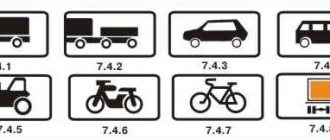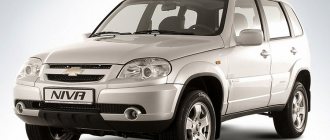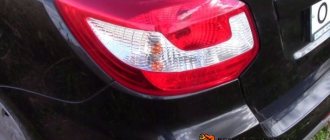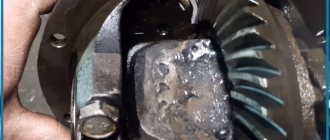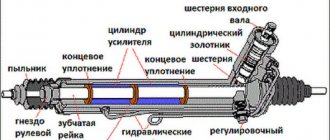For novice drivers, the greatest difficulties are caused by the technique of overtaking and parking. Also of particular importance is the question how to turn properly on corners. In this article we will look at car turning techniques.
Moving a car involves performing various driving techniques and maneuvers, which include the so-called turn. To learn how to turn correctly when turning, you need to master the turning technique.
The correct turn is characterized by accuracy, speed, safety, which is accompanied by an appropriate response from the driver in certain driving conditions and is performed in accordance with established traffic rules.
Technique for turning a car
Mastering the turning technique involves learning four basic techniques:
- Driving along a straight road - that is, approaching a turn;
- Directly entering a turn , which is accompanied by turning the steering wheel;
- Car movement in a turn;
- Exiting a turn is accompanied by the driver returning the steering wheel to its original position.
The correct turn of the car is influenced not only by the speed and trajectory of the car during the turn, but also by the operating mode of the engine.
What is an automatic transmission
An automatic transmission is one of the types of transmission in which the required gear ratio is automatically selected without driver intervention, taking into account the nature of the movement, speed and other parameters.
In a car with an automatic transmission, there is no clutch pedal due to the fact that the clutch is replaced by a torque converter, which transmits torque to the wheels.
Starting a car with automatic transmission
To ensure the safety of the automatic transmission, several types of protection are provided in the car.
Vehicle speed when turning
Before entering a turn, you must reduce the vehicle speed. It should be remembered that while the car is passing through an arc, it is necessary to maintain a constant speed.
The safety of turning depends on the vehicle turning correctly. To make a safe turn, you should begin to reduce speed on a straight section of the road well before the turn, which eliminates the effect of wheel slipping and the possibility of the car skidding when turning.
We briefly looked at what you need to consider when approaching a turn - speed and trajectory. And now in more detail about the driver’s actions when entering a turn, driving in a turn and exiting a turn.
Features of correct cornering
Correct cornering is one of the basic skills that every driver should master perfectly. Despite its apparent simplicity, this maneuver can be dangerous, especially if performed at speed. What should you consider when driving your car around a turn, so as not to get into an unpleasant situation?
There are no identical turns
Every driver must remember that the cornering technique is not universal, one for all occasions. Each turn has its own nuances, differing from others, first of all, in the steepness and smoothness of the road. Although some points must always be taken into account, no matter how complex the turn:
How to use the gas pedal when cornering?
When driving a front-wheel drive car, when performing a maneuver it is necessary to gradually increase the pressure on the accelerator, but this must be done very smoothly, otherwise the wheels will begin to slip (among motorists this phenomenon is called skidding) with subsequent skidding of the vehicle. When driving a car with rear-wheel drive, on the contrary, the gas should be reduced before passing the maximum turning point, and gradually added only after passing the peak.
When approaching a turn, you need to stop braking. The clutch and gear should not be disengaged. You can pick up speed in normal mode when the car is completely out of the turn.
It is important to remember that you should always move smoothly when turning. When driving on a winding road, when they follow one after another, the gas supply must be reduced so that you can reduce the speed in time without using the brake pedal.
Turning trajectory
Driving on mountain roads
Roads in the mountains, replete with sharp turns, are called serpentines. The nuances of driving along serpentine roads are the same regardless of the direction of movement - down or up.
When driving onto a serpentine road, you need to make sure that there is no other car coming towards you - when turning, it is better not to “share” the road with other vehicles. If there is oncoming traffic, it is better to let it pass.
When going down a mountain road, before making a right turn you need to move to the left side. In this case, when entering a turn, the car can be kept in its lane. Just like on a flat road, you need to stop braking and changing gears before entering a turn. You should not drive in high gear. And be extremely careful - the slightest mistake by the driver when driving along the serpentine road will lead to tragedy.
A long turn on a mountain road is not a pleasant experience, since the driver cannot see where it ends. Therefore, when passing it you need to constantly be on guard.
Based on the above, it is necessary to recall once again that every driver is required to practice cornering until it becomes automatic, since both his personal safety and the safety of passengers depend on this.
Correct entry of the car into a turn
So, correct entry into a turn implies an early reduction in speed before the turn, which will ensure that the turn is passed at a reduced speed. The vehicle speed before turning should be selected depending on the turning conditions and the condition of the road section. In unfavorable road conditions, in the presence of possible additional obstacles, the speed when turning should be significantly reduced.
Before the car enters a turn, you should pay attention to the point of fixation of attention and the position of your hands on the steering wheel.
When turning, the driver's attention should be directed to the exit point of the turn (that is, the driver must imagine the final picture of the turn, its result).
If the driver is unable to view and visualize the result of the turn, or visibility is obstructed, measures should be taken to reduce the vehicle speed as much as possible before the turn.
Basic taxiing methods
We examined in detail the technique of hand movements and identified two main methods of steering - simple and high-speed. In real life, you need a simple method in 90% of cases, because... When driving, you always need to turn the steering wheel slowly and at small angles, except when skidding on a slippery road.
It is extremely important to skillfully operate the steering wheel when cornering, because... this is the lion's share of success. We know the simple taxiing technique, but its timely application is no less important. Turning the steering wheel in a simple way means that the driver's hands never leave the steering wheel rim, sliding consistently along it.
No matter how hard the driver tries, if during the turn he turns the steering wheel with one hand (while simultaneously slipping the other hand), the movements turn out to be stepped. In addition, one hand, due to the increased load, is able to feel significantly less reaction on the steering wheel (i.e., what is happening to the front wheels) than two hands. Therefore, it is advisable to act in such a way that in the middle of a turn there is no need to turn the steering wheel, but you can simply hold it with both hands.
To do this, you should grab the steering wheel in advance, when approaching a turn, so that you can carry out the entire maneuver with both hands. This method is called pre-capture.
Diagram of the correct turn of the car
- Before turning, the driver smoothly depresses the brake pedal to reduce speed (if necessary, a lower gear can be used).
- Determining the vehicle's trajectory. The steering wheel is turned with both hands, according to the grip pattern.
- The driver's gaze is fixed on the point where the car exits the turn. When the car passes through a turning arc, a constant speed is maintained.
- Exiting a turn is accompanied by the steering wheel returning to its original position and a smooth increase in vehicle speed.
A novice driver must practice the technique of making turns Over time, drivers become overconfident when making various difficult turns, which can affect driving safety. Don’t take risks, control yourself, follow the technique of making turns. Bring the correct technique for performing a turn to automaticity. Have a safe ride.
Automatic driving for beginners
So, the automatic transmission selector lever has several main positions: P, R, N, D, D2 (or L), D3 or S. Let's look at each one separately.
- The position of the gear shift lever is in the “P” position - parking. The vehicle cannot move, but in this mode the engine can be started.
- The position of the gear shift lever in the “R” position is reverse. Reverse. This position cannot be used while the vehicle is moving forward. In this mode, the engine cannot be started.
- "N" - neutral.
The car can move freely. In this mode, starting the engine and towing the car are allowed. The position of the gear shift lever is in position “D” – drive (main driving mode). This mode provides automatic shifting from first to fourth gear (recommended for use in normal driving conditions). - Position the gear shift lever in position D3 (S) second range of low gears (on roads with slight inclines and descents) or D2 (L) range of low gears (off-road).
Not all automatic transmissions have such switching modes; it all depends on the modification of the transmission. The lever can be switched from position D to position D2 or D3 and back while the vehicle is moving. Automatic transmissions can also be additionally equipped with gear shift modes: N – normal, E – economical, S – sport.
Traveling in winter in a car with automatic transmission
Most car owners do not know the nuances of driving with an automatic transmission in winter, so with the onset of cold weather they begin to have problems with the car, for example, the gearbox starting to make noise. Advantages in cold weather:
- Smooth movement and excellent integration with various electronic devices - assistants;
- The risk of slipping on ice with an automatic transmission is much lower than with a manual transmission;
Disadvantages in cold weather:
- Problems - if you forgot to warm up the box;
- Inappropriate gear shifting, causing jerking when moving the car. The wrong action in this case is to drive “pull”;
How to tow a car with automatic transmission
Even a driver who has already acquired the skills of driving a vehicle with an automatic transmission must know these simple rules in order to keep the transmission intact:
- A car equipped with an automatic transmission must not be towed for a long time with the engine turned off. The fact is that the lubricant inside the automatic transmission moves only under a certain pressure, which appears only when the car engine is running. It is correct to tow in the “neutral” position of the automatic transmission, with the engine running. The second safe option is towing with the drive wheels hanging out. The third option is a tow truck;
- When the automatic transmission or engine of a car does not work for some reason, transportation of the car is permitted only with the help of a tow truck, in order to avoid new breakdowns. The only exception will be some cars from “Germany”, which are allowed to be towed for a distance of no more than 50 kilometers, at a speed not exceeding 50 km/h;
- It is possible to safely tow another vehicle with a car equipped with an automatic transmission if certain conditions are met: when the towed vehicle is lighter than the towing vehicle; when there is a position “1” or “L” so that the load on the box is minimal;
- It is permissible to drive an automatic vehicle with a trailer, just keep in mind that the increasing load causes the hydraulic transformer to overheat. It is advisable not to drive with overdrive gears and mount an additional radiator on the box if you plan to drive with a trailer all the time;
Overtaking a car with automatic transmission
There are times when a driver needs to overtake a slower vehicle in front. The maneuver is simple - just press the accelerator pedal to the floor. At the same time, the box goes into kickdown mode, which gives rapid acceleration to the car (some drivers call this urka mode because the car makes a “urrr” sound). Having completed the maneuver, just release the accelerator and the car will return to its previous speed limit.
Some instructions allow you to drive a car with an automatic transmission in selector positions “3” and “2” in order to use the braking effect of the engine. Such movement is permissible only during long descents, where there is a danger of getting into a skid if the drive wheels are blocked when braking. Such switching is especially dangerous when the road is slippery from rain or ice; there is a very high chance of flying into a ditch or getting into an accident.
How to use an automatic transmission correctly in traffic jams and at traffic lights?
At traffic lights or in traffic jams, it is easier to drive with an automatic transmission. To stop at traffic lights, simply depress the brake pedal. When standing in a long traffic jam, the leg may get tired from constantly pressing the pedal, so in traffic jams use the “P” mode. When it is necessary to move again, squeeze the brakes and switch to position “D”.
On a hot summer day, it is recommended to use the “P” position when the car is idle for short periods, so as not to overheat the lubricant in the transmission.




